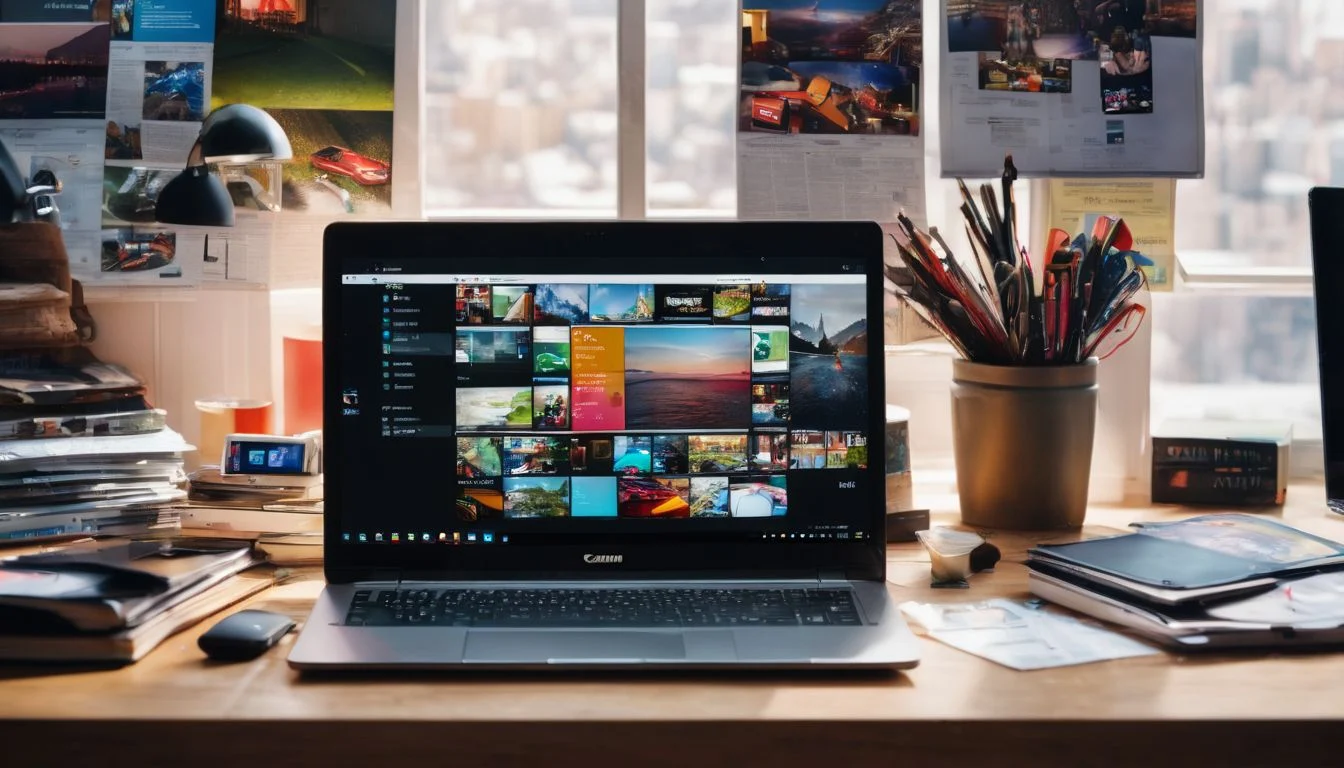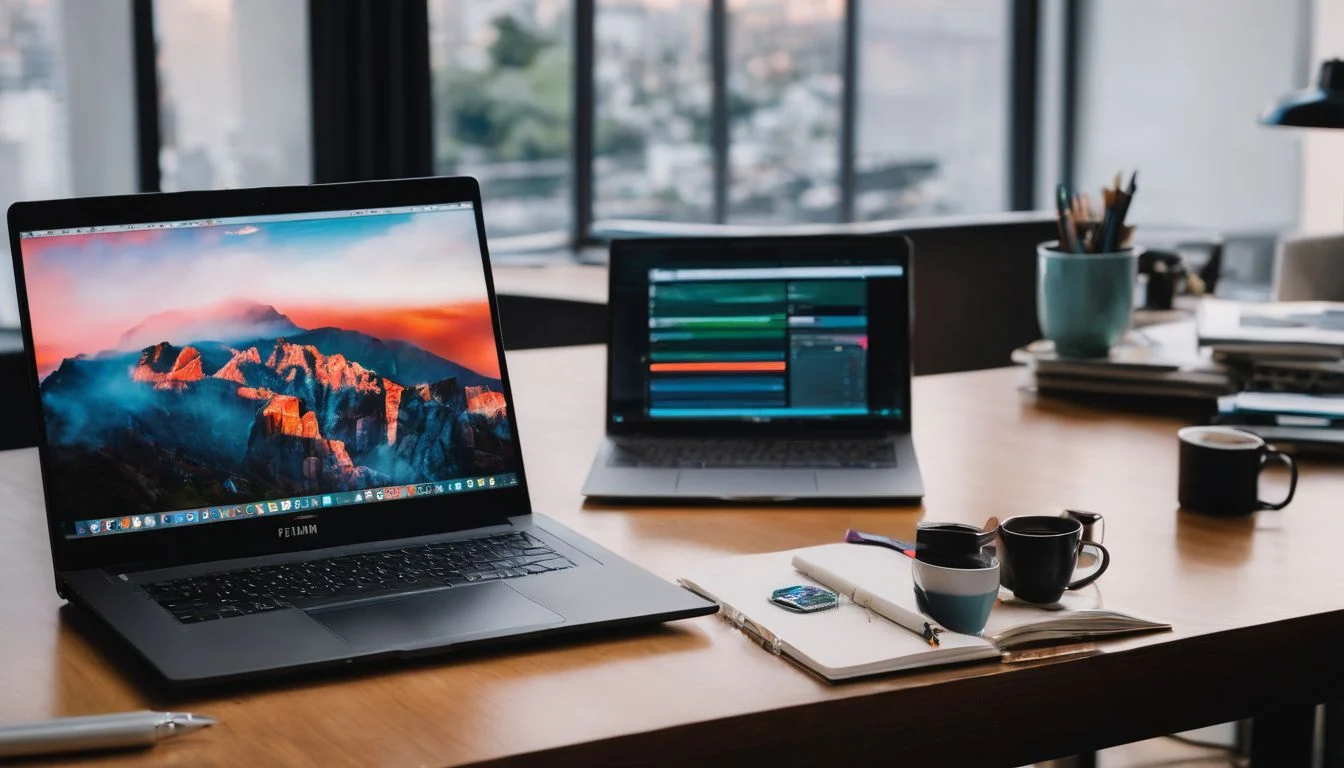Are you finding that your fingers can’t keep up with your thoughts when typing out an email or working on a project? Do errors creep in, slowing you down even more as you backspace and correct each mistake? You’re not alone.
Boosting your typing speed and accuracy can make a massive difference in how efficiently you work and communicate.
Believe it or not, by gently adjusting the way you tap the keys, progress is just around the corner. This article will shine a light on five easy-to-follow tips that promise to enhance both speed and precision of your typing skills.
From nailing the basics to mastering advanced techniques, we’ve got strategies for every stage of your keyboard journey. Ready to leave those typos behind? Let’s dive in!
Key Takeaways
- To boost typing speed and accuracy, get to know your keyboard and practice not looking at your hands while typing.
- Learning proper finger placement on the home row keys can help reduce mistakes and strain.
- Start with slow, accurate typing to build a strong foundation before focusing on speed.
- Practise timing drills and test your WPM regularly to track progress and set goals for improvement.
- Use different materials like books or online games for practice outside work to keep improving.
The Importance of Good Typing Skills
Having good typing skills is essential as it improves communication, increases productivity, and enhances your CV. It’s a skill that will benefit you in various aspects of your life, so it’s worth investing time to improve.
Improves communication
Typing well helps you share your ideas quickly and clearly. When you type fast and without errors, people can understand you better. This is great for sending emails or chatting online.
If your typed words are easy for others to read, they will get your message the way you mean it.
Good typing skills also mean less time fixing mistakes. You can answer more messages in less time. When friends or workmates get quick replies from you, they know they can count on you to talk with them when needed.
That makes working together much easier!
Increases productivity
Improving your typing skills increases productivity by allowing you to complete tasks faster and with fewer errors. As you type more efficiently, you can spend less time on repetitive tasks and focus on more important work.
With better accuracy, you won’t have to go back and correct mistakes, saving valuable time that can be used for other essential duties. By enhancing your typing speed, you’ll be able to accomplish more in less time.
With these improvements in place, let’s move on to discussing the “Beginner’s Tips for Improving Typing Skills” and how they can help lay a solid foundation for enhancing your typing abilities even further.
Enhances CV
Improving your typing skills can significantly enhance your CV. Employers value candidates who can type fast and accurately, as it demonstrates efficiency and attention to detail. Good typing skills are essential in many professions, showing that you are capable of handling tasks quickly and accurately.
Consistently practicing and improving your typing speed will showcase dedication and a desire for self-improvement on your CV, setting you apart from other candidates. Remember, having strong typing skills is increasingly important in today’s digital workplace.
Let’s now explore the beginner’s tips for improving typing skills.
Beginners Tips for Improving Typing Skills
Familiarise yourself with the keyboard and its layout to increase your typing speed. Learn the proper typing position, such as keeping your wrists straight and using all of your fingers, to avoid fatigue and strain.
Start slow when practicing to avoid making mistakes that could become bad habits in the long run.
Familiarise yourself with the keyboard
Get to know the keyboard layout by identifying all the letters, numbers, and symbols. Practise finding each key without looking down. This will help in developing muscle memory for where each key is located.
Additionally, practise typing simple words and sentences to get used to the placement of keys. Start from the home row position and gradually try reaching for keys further away. This will improve your typing accuracy as you become familiar with the keyboard layout.
Remember that consistent practise and patience are essential when starting out with keyboard familiarisation, which is an important foundation for improving your typing skills.
Learn proper typing position
After familiarising yourself with the keyboard, it’s essential to learn the proper typing position to improve your skills. Place your fingers on the home row keys and maintain a relaxed posture with wrists slightly elevated.
This positioning helps in reducing strain and increasing typing speed while ensuring accuracy. Keep practising this hand placement until it becomes natural – this will contribute to improving your overall typing skills and efficiency.
Remember, prioritising proper hand placement over speed at first is crucial for enhancing accuracy and preventing fatigue during long typing sessions. Also, maintaining good wrist position can help in avoiding repetitive strain injuries associated with prolonged periods of typing.
Start slow to avoid mistakes
To enhance your typing skills, it’s important to learn the proper typing position first. Once you’re comfortable with the hand placement, start slow to avoid mistakes. Typing slowly in the beginning helps improve accuracy and reduces errors, setting a solid foundation for speedy and precise typing in the future.
Remember that prioritising accuracy over speed is crucial for improvement. By starting slow and focusing on hitting the right keys, you’ll gradually build muscle memory and confidence.
This approach also allows you to maintain proper posture and hand placement while typing, contributing to more efficient and comfortable sessions at the keyboard. So take your time, get familiar with each key, and watch as your accuracy improves steadily.
Intermediate Exercises to Improve Typing Skills
Practice typing without looking at your hands and try timing drills to enhance your skills. Read on for more tips to improve your typing speed and accuracy!
Exercise 1: Typing without looking at your hands
Try typing without looking at your hands. This helps you get familiar with the keyboard. It also improves your typing speed and accuracy over time, even if it’s slow in the beginning.
Proper hand placement is crucial for this exercise. It’s okay to make mistakes at first because practising this way will help you improve.
Typing without looking can feel difficult, but it helps you memorise key placements. Slowly build up your speed as you become more comfortable. Remember, accuracy is more important than speed at first! With consistent practice, this exercise will train your muscle memory and improve your overall typing skills.
Exercise 2: Practising with timing drills
After getting comfortable with touch typing, you should move on to practising with timing drills. This exercise helps in improving both your speed and accuracy. Timing drills challenge you to type at a faster pace while maintaining precision.
Set specific time intervals and try to type as much as you can within that duration without compromising accuracy. This exercise is an effective way to push yourself beyond your comfort zone and gradually increase your typing speed.
Consistent practice with timing drills will help in enhancing your WPM (Words Per Minute) over time. It’s important to focus on maintaining accuracy even as you aim for higher speeds.
Advanced Methods for Enhancing Typing Skills
Cover your hands while typing to improve accuracy and speed, use material outside of work to practice typing, and test your typing speed and accuracy regularly. Read more to master the art of fast and accurate typing!
Cover your hands while typing
To improve your typing skills, covering your hands while typing can be beneficial. This technique encourages you to rely on muscle memory and enhances your familiarity with the keyboard layout, leading to increased accuracy and speed.
This method helps in reinforcing proper finger positioning, making sure that you hit the right keys without looking at them. By practicing this way, you can gradually build up your confidence and fluency in typing, eventually improving both your WPM (words per minute) and accuracy.
Additionally, using material outside of work for practice like articles or books will expose you to different words and sentence structures, further honing your typing skills. Moreover, consistently testing your typing speed and accuracy provides a clear measure of progress while setting achievable goals ensures continuous improvement.
Use material outside of work
Incorporating typing practice into your everyday activities can help improve your skills. For example, you can use online resources and games to make learning to type more fun and engaging.
Additionally, finding interesting articles or passages to type out as a way of practicing can also enhance your speed and accuracy whilst being beneficial for increasing words per minute (WPM).
Furthermore, trying different keyboard layouts like the Dvorak layout could be an interesting challenge that might aid in improving your overall typing proficiency.
Test your typing speed and accuracy
To check your progress and see how much you’ve improved, test your typing speed online. You can find free websites that offer typing tests. These tests measure the number of words you can type per minute (WPM) and assess your accuracy.
Regularly testing your speed can help track improvement over time as you continue to practice and use different typing exercises to enhance your skills.
Setting achievable goals and regularly tracking your progress through these tests will help motivate you to keep improving. Remember, consistent effort in practicing is key to seeing real growth in your typing speed and accuracy.
Conclusion
In conclusion, you’ve learned essential tips for improving your typing skills. These practical strategies focus on building accuracy and speed. Have you started setting achievable goals for progress? Remember to prioritise accuracy over speed as you practice.
Consider testing your current typing speed and track progress regularly. Keep practising consistently – small efforts make big improvements!
FAQs
1. What are some tips to improve typing speed?
To increase your typing speed, practise regularly, get familiar with the keyboard layout, and aim to type without looking at the keys.
2. How can I type more accurately?
Improve your accuracy by taking time to learn proper finger placement on the keyboard and slowly build up your Words Per Minute (WPM) as you get better.
3. Can playing typing games help with keyboard skills?
Yes, playing typing games is a fun way to work on both speed improvement and accuracy in typing as they make learning feel like play.
4. Should I always look at the screen when practising my typing improvement?
It’s best not to look at the keyboard while practising; this helps you memorise key positions and boosts your WPM for better keyboard familiarity.




